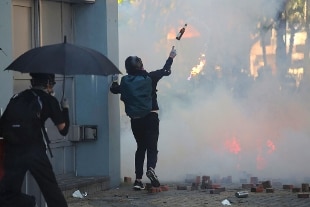- Hong Kong, a policeman shoots and seriously injures a 21-year-old protester
- Hong Kong, new clashes. Four stabbed in the mall
- Hong Kong, the protest rekindles
Share
November 18, 2019Caos at the Polytechnic University (PolyU) in Hong Kong, on the Kowloon peninsula, where at dawn the police broke in to try to get a hold on the approximately 200 protesters barricaded after a day marked by violent clashes. To slow down the attack, the students set fire to the main entrance, giving off a big fire, and threw Molotov cocktails at the agents. The police have withdrawn but let it be known that it is a temporary suspension of the use of force to allow students to leave the campus peacefully and surrender to the police.The police, in a statement released online by the Hong Kong administration, denied that they had conducted a raid on the PolyU, talking about crowd-dispersal operations and arrests, but the tension remains high: several protesters on the campus would be on point of a nervous breakdown after a day of siege, the local media report, and the group would be split between those who say they are ready to leave and those who are determined to stay. The police also fired three shots before dawn to disperse the crowd, which had targeted an ambulance with brick throws and other objects. The first budget of the clashes that began yesterday speaks of 38 injured people, including an 84-year-old man. In the morning on Kowloon, dozens of people - at least forty, but whose number could rise to a hundred, second several estimates - were arrested at Golden Plaza. Mostly young, those arrested were handcuffed with plastic cables and seated face to face and kept under surveillance by riot police. Meanwhile, protesters outside the besieged campus are beginning to reorganize: at Nathan Road, Kowloon's main street, groups have appeared in the street to restore roadblocks, and new scenes of tension between police and protesters have been resumed always on the Kowloon, in what appears to be an attempt to distract the police from the siege of the PolyU.
Thus the impasse continues: within the Polytechnic, which has become the basis of the pro-democracy movement, several hundred protesters barricaded, armed with Molotov cocktails, arrows and stones. According to the police, in recent days they have looted the laboratories, taking highly flammable materials that can be used to make explosives. Off campus, a cordon of agents deployed to prevent students from escaping, entrenched behind shields and armored vehicles. All Sunday, and even night until morning, the two groups played cat and mouse, the police using tear gas and water cannons firing a stinging blue liquid, the boys responding with improvised ammunition like bricks and molotov. Yesterday an agent was injured by an arrow that pierced his calf; the security forces reacted, warning the protesters: no more attacks or they could switch to the "minimum necessary force", including gunshots.
China has repeatedly warned that it will not tolerate dissent and there is a growing fear that Beijing will send troops to end the unrest: on Saturday the soldiers of the Chinese People's Liberation Army stationed in Hong Kong fell for the first time turn to the streets since the beginning of anti-government protests, officially to remove the bricks. But it was still an impressive display of efficiency. In recent days, Chinese President Xi Jinping used very strong words, arguing that the crisis threatens the "one country, two systems" model (under which Hong Kong was governed after the handover from Great Britain in 1997) and that ending violence and restoring order are "the most urgent task". Concept also reiterated by the Chinese ambassador in Italy, Li Junhua, who warned: "If the situation continues to deteriorate, the Chinese central government will not sit and watch".

